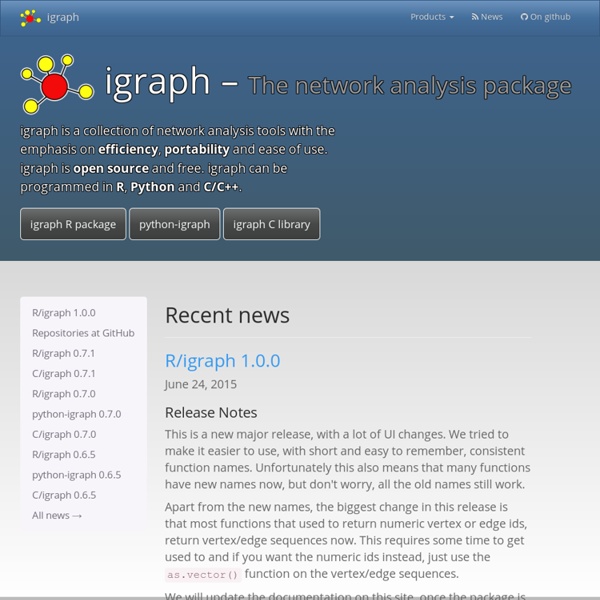S Routines for Social Network Analysis in the R Environment
Most of which involve social network analysis, though a wee bit 'o other stuff is available as well.... Introduction and Caveats This page serves, as one might expect, to allow other researchers to access some of the data analysis tools I've developed in the S language. The implementation of S used here is that of the R Statistical Computing Environment , rather than the common alternative of S-PLUS ; the intrepid could doubtless port these routines from one flavor of the language to the other, however. Caveats: This software is provided on an unsupported, as-is basis, under the terms of the GNU Public License . Getting and Using R The R statistical computing environment is distributed under the GNU Public License , and can be freely obtained either as source or as precompiled binaries for a wide range of platforms. The Statnet Project Most of the material contained here is now part of the Statnet Project , a collaborative effort to develop Free Software tools for network analysis.
Urwid
JUNG - Java Universal Network/Graph Framework
Overview — NetworkX 1.7 documentation
facebook's tornado at master - GitHub
Cytoscape: An Open Source Platform for Complex Network Analysis and Visualization
DSLs em Python | Andrews Medina
introdução DSL (Domain Specifc Language) é uma linguagem limitada com o objetivo de atender um domínio específico. Ou seja, DSLs são uma forma diferente de programar, onde é criado uma sintaxe que se aproxime mais do domínio do qual ela faz parte. A linguagem de programação escolhida para construir a DSL afeta totalmente em como será a sintaxe da DSL. Python mesmo sendo dinâmica tem várias burocracias, como endentação obrigatória, monkey patch limitado, que limitam a construção de DSLs, mas por outro lado, Python, tem características que podem ser utilizadas, como: sobrecarga de operadores, decorators e modificação do encoding. Nesse post eu mostrarei como utilizar essas técnicas para construção de DSLs, e mostrar bibliotecas em Python que já as utilizam. sobrecarga de operadores Há duas formas de utilizar a sobrecarga de operadores para construir DSLs. Ele pode ser utilizado para realizar a adição, somando dois números: Pode ser utilizado para concatenar duas strings: >>> imagem1 + imagem2
Gephi, an open source graph visualization and manipulation software
The Open Cognition Project - OpenCog
Vision We're creating an open source framework for Artificial General Intelligence, intended to one day express general intelligence at the human level and beyond. That is: We're undertaking a serious effort to build a thinking machine. We've developed a detailed plan, possess the ability to execute it, and we're proceeding with the hard work step-by-step. As compared to most academic and industry AI research, the OpenCog project has a very different focus. OpenCog is a moderate-sized and active project with: a team in Hong Kong working on intelligent game characters a new OpenCog lab in Addis Ababa, Ethiopia, with a staff of 5 developers in the Americas, Europe, Asia, Africa, the Middle East, and Australasia, working for various employers and applying OpenCog on commercial and government projects many fantastic volunteer developers Our vision is a huge one and we are eagerly recruiting new developers! OpenCog & OpenCog Prime OpenCog has two overlapping aspects: OpenCog Foundation Donate News
Pajek / How to: Convert Excel datasets into Pajek format
Jürgen Pfeffer, from FAS.research, Vienna developed a program that converts Excel datasets into Pajek format: At the Pajek workshop in Portoroz I promised to send you the algorithms to convert Pajek files from an Excel dataset. Inspired by your program I made an executable windows program which imports the data from an Excel file and converts these data to a pajek file. The program contains an info button, therefore it's not necessary to add an explanation. I think the program is rather fast. Download the program How to?
How do you remove duplicates from a list in Python



